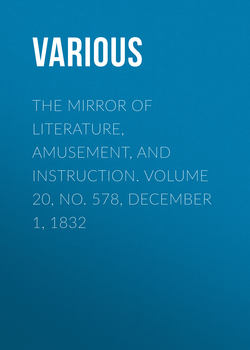Читать книгу The Mirror of Literature, Amusement, and Instruction. Volume 20, No. 578, December 1, 1832 - Various - Страница 1
TANFIELD ARCH, DURHAM
ОглавлениеTANFIELD ARCH, DURHAM.
Tanfield is a considerable village, situated seven miles from Gateshead, in the county of Durham, and eight miles in a south-west direction from Newcastle-on-Tyne. The above arch is about a mile from the village, and crosses a deep dell, called Causey Burne, down which an insignificant streamlet finds its sinuous course. The site possesses some picturesque beauty, though its silvan pride be
After a season gay and brief,
Condemn'd to fade and flee.
It has much of the poet's "bosky bourne," and beside
The huddling brooklet's secret brim,
his pensive mind may feed upon the natural glories of the scene; while, attuned to melancholy,
In hollow music sighing through the glade,
The breeze of autumn strikes the startled ear,
And fancy, pacing through the woodland shade,
Hears in the gust the requiem of the year.
KIRKE WHITE'S Early Poems.
The ARCH was an architectural wonder of the last century. It was built in the year 1729, as a passage for the wagon-way, or rail-road for the conveyance of coals from collieries in the vicinity of Tanfield, which were the property of an association called "the Great Allies." It is a magnificent stone structure, one hundred and thirty feet in the span, springing from abutments nine feet high, to the height of sixty feet: a dial is placed on the top with a suitable inscription. The expense of its construction is stated to have amounted to 12,000l.; the masonry is reputed to be extremely good, and the arch itself is nearly perfect, though it is now only known as a foot-way, the collieries for the use of which it was built, being no longer worked: previously it was but a private road-way. In Cooke's Topography we find it stated, (though it is not mentioned upon what authority,) that the architect built a former arch which fell, and that the apprehension of the second experiencing the same fate induced him to commit suicide.
Before the building of the New London Bridge, the arch at Tanfield is said to have been the largest stone arch in existence. The span of the central arch of the bridge is 152 feet; and that of the arches on each side of the centre, 140 feet: the span of the arches of Waterloo Bridge is 120 feet; so that the reader may form a tolerably correct estimate of the arch at Tanfield.
THE RESTING-PLACE
Where shall this wounded, aching breast.
Find a couch of soothing rest—
A respite from its woes?
Friend! mark'st thou that grassy bed,
The cold, clay dwelling of the dead—
There, there is sure repose.
When shall this soul, so long borne down
By Fate's despite and with'ring frown,
A rescue know from care?
Friend! when that dark home is thine,
Never more thy heart shall pine—
Grim sorrow comes not there.
When thy name is of that number,
Sound and sweet will be thy slumber;—
All earthly pangs and troubles cease,
Nor dare invade that house of peace.
On that pillow, ozier drest,
The worn, the "weary are at rest."
Thy broken heart shall cease to sigh,
And tears forsake that sunken eye;—
No dreams distract that holy sleep—
No tempests break that calm so deep.
Come, then!—forsaken, wearied, come!
Here is for thee a peaceful home.
Sarum.
COLBOURNE.
THE HORSE "ECLIPSE."
A warm—hearted Correspondent, "W.C." of Milton (who is anxious for our accuracy on all points), wishes us to correct an error or two in the account of Eclipse, at p. 362, vol. xix. of The Mirror. It is there stated that Mr. Wildman sold the moiety of Eclipse to Colonel O'Kelly, for 650 guineas; and that O'Kelly subsequently bought the other moiety for 1,100 guineas. But, our Correspondent, who was for many years intimate with both the above gentlemen, assures us that "the Colonel gave to Mr. Wildman 2,000l. for a moiety of Eclipse, and subsequently 2,000l. for the other moiety—making the whole purchase-money 4,000l."
In the page wherein the above mis-statement appears is another error, respecting the speed of Childers—"over the round course at Newmarket, 3 miles, 6 furlongs, and 93 yards, in 6 minutes and 40 seconds; to perform which, he must have moved 82-1/2 feet in a second of time, or at the rate of nearly one mile in a minute." We have referred to the work whence the above was quoted (Hist. Epsom, p. 103), and find it to correspond with our reprint. The calculation is evidently incorrect: for Childers would thus appear scarcely to have exceeded half a mile a minute.
